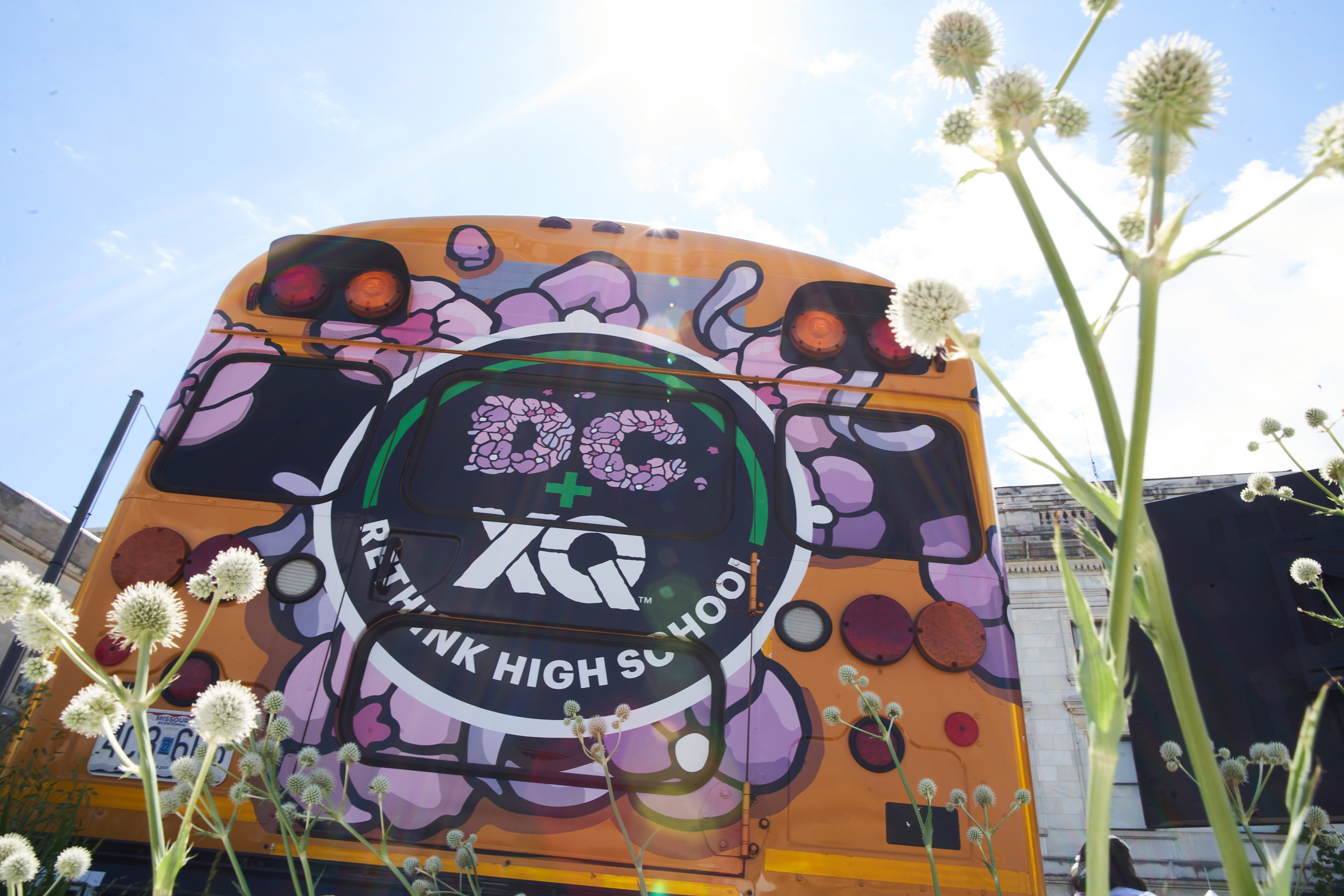3 Tips for Teachers to Foster Student Internships in High School
Did you know that you can get a paid internship in high school? These two students engaged in real-world projects with industry partners. Learn how.

As students navigate the complexities of school and life, many find opportunity, growth—and a paycheck—in internships linked to academic learning and real-world experience.
Schools around the country, including XQ schools, often partner with local businesses and organizations to provide meaningful internships for students that can give them valuable work experience, a head-start on their career, and much-needed income. This approach to meaningful, engaged learning through community partnerships is a powerful combination for rethinking high school.
These internships not only provide on-the-ground, practical experience, but they can spur renewed interest in school and academics. And for students whose mental health suffered during remote learning, well-organized internships can bring a sense of purpose and optimism.
Skyler Hilton, a recent graduate of Elizabethton High School in rural Tennessee, an internship changed his life. An interest in computers at school led to an internship at Lobaki, a virtual reality firm in Mississippi, which led to a well-paying, full-time job after he graduated.
“I love it here. It’s been amazing. I wake up excited to go to work,” said Skyler, who grew up in a low-income family and said he’d never have been able to accept the internship if it didn’t pay.
“There’s nothing like real job experience,” he added. “I’ve learned and progressed so much…And it’s exciting to be a part of the VR industry. VR has so much potential, and we’re only beginning to see what that is.”
Why Are Internships Important?
Today’s students need to be prepared to live in a global society—to be excited about emerging fields and ready to meet world challenges. That means we must give them critical thinking skills and encourage their creativity to meet the demands of the 21st century.
Internships do this by connecting students to real-world learning opportunities. Internships bridge the gap between the classroom and the world beyond, encouraging meaningful and engaged learning as students understand that what they’ve learned in school has real life applications. By allowing students to work on meaningful projects outside of the classroom, internships empower students as leaders, collaborators, and critical thinkers—in short, the real-life skills students will need for future success. Internships also give students a concrete leg up on future academic and career opportunities. These benefits include:
- Exposure to career and job pathways
- Professional experience
- Potential salary
- Increased confidence
- Competitiveness for future job and college opportunities
These benefits of internships are clear at Washington Leadership Academy (WLA) in Washington, D.C. At WLA, all eleventh grade students are required to complete an internship with a community partner, with the goal of preparing students to apply what they’ve learned in school to take the lead in the future. This was certainly true for WLA alum Jermoe Foster. Foster interned with the late civil rights icon, Rep. John Lewis. From this high school experience, Foster now runs One Million of Us and serves as the youngest member of the Biden administration. He credits the real-world education he got at WLA with helping him reach this point, describing the impact of his high school experience: “It’s about empowering my generation to be adventurous and try new things. And take action.”
Similar to Jerome, Levi—an Elizabethton student who, along with Skyler, interned at Lobaki—gained professional confidence through his internship. “It seemed that my life was always about checking off lists. Now I feel like I’ve gone from the status quo to being a complete outlier,” explained Levi. “This internship has gotten me out of my shell. It’s been really rewarding.”

How Educators Can Set Students Up for Success Through Internships
Reaping the benefits of internships isn’t as simple as telling your students to send out applications and see what happens. Creating opportunities for internships that are meaningful, relevant, and constructive takes intention—but it’s worth it. The suggestions below will help you connect your students with opportunities that further their career and academic interests, and help them grow as learners and community members.
1. Engage Students in Real-World Projects with Industry Partners
Schools exist within a community, connected to the people and organizations around them by a shared economic and social context. However, too often schools function detached from the communities they exist within and serve. Educators can build community engagement and partnerships by connecting with local businesses for internships programs. Many times, creating these engagements is as easy as asking!
For instance, Elizabethton High School’s partnership with Lobaki came about when educators saw a TV news program that highlighted the importance of training and mentoring young people in rural areas in the tech industry. Given the immediate alignment to Elizabethton’s mission and culture, Teacher Alex Campbell reached out to Lobaki’s chief executive, Vince Jordan, to set up an internship program with the school. By reaching out to Jordan and forming a relationship around shared goals, Campbell secured an opportunity for students to build on their VR skills through real-world experience.
Similarly, educators at Brooklyn Laboratory High School—an XQ school in Brooklyn, NY—recognized that they could use internships to correct the inequitable patterns that too often keep low-income students of color from connecting with crucial professional opportunities. LAB educators created a database of over 300 potential host organizations for internships, and then reached out to those that seemed most aligned with student needs. The community responded. Now, LAB students regularly intern with organizations like The Smithee Group, a Brooklyn-based digital marketing agency, gaining valuable professional experiences.
To engage your students with industry partners:
- Ask: What industries best align with my students’ future career and academic goals?
- Brainstorm a wide list of community organizations to approach about internships.
- Look for businesses and nonprofits that have an interest in empowering young people.
- Reach out! Invite organizations to visit campus and see student work, and focus on building sustained relationships.
2. Use Rigorous Coursework to Prepare Students for Real Jobs
As educators, you may be wondering or worried that your students are not prepared for success in internships and real-work experience. However, you have the power to intervene. Prepare your students for success by providing them with rigorous coursework that emphasizes real-world skills and knowledge.
Elizabethton High School took this approach when preparing students for internships that align with their mission to engage students in new tech industries. In order for those students to succeed in their internships and compete with students in other parts of America, educators at Elizabethton spent time creating rigorous STEM coursework. They launched a virtual reality program, so some students would have the basic skills to do entry-level VR work.
Elizabethton’s approach shows how part of the work of preparing students for internships can be specific to the opportunity. Consider how you can teach students skills that will make them competitive for internships in particular industries. What hard skills can you teach your students that will empower them to hit the ground running in a given professional context?
You can also prepare students for success in internships and jobs by focusing explicitly on how to navigate the professional world. For example, Brooklyn Lab prepares students for the internship process by having students conduct mock interviews, build marketable résumés, and learn how to set professional goals. Giving students support in these soft skill areas can boost student confidence, and empower students to make the most of their time outside of the classroom.
More broadly, preparing students for success in their internships means teaching students to think critically, and preparing them to meet the kinds of issues that come up in real-world contexts. Students should be prepared to meet challenges with creativity and determination, especially challenges they haven’t yet encountered in the classroom. To prepare your students with these thinking skills, consider approaches to teaching and learning that are:
- Project-based: Students gain academic skills and knowledge by taking on authentic challenges, preparing them with the creativity, organization, and collaborative skills they’ll need for real world work.
- Competency-based: Students progress through content based on how well they’ve mastered the material, rather than time spent in seats. This approach prepares students to evaluate their own progress and seek feedback on how they can improve, rather than relying on a grade to know they’ve been successful.
- Interdisciplinary: Students apply learning from multiple disciplines to come up with approaches to challenges or questions that don’t fit neatly within a single subject—much like the challenges they’ll face on the job.
3. Align Design Principles with Internships
Once you’ve connected with an industry partner to provide an internship opportunity, and you’ve given your students the preparation they need to take on real-world challenges, the final step is making sure the actual experience of the internship supports student learning.
Based on research and work with high schools across the country, we developed six design principles for rethinking high school.
- Strong mission and culture
- Meaningful, engaged learning
- Caring, trusting relationships
- Youth voice and choice
- Smart use of time, space, and tech
- Community partnership
To consider whether a student internship embodies these design principles, you can ask yourself the following questions. If the answer to any of these questions is “no,” take that as an opportunity to rethink and redesign part of the internships experience:
- Does the internship align with the overall mission of the school on key areas, like equity and rigor?
- Does the work accomplished during the internship connect to learning competencies and standards?
- Does the internship provide opportunities for students to develop mentor relationships with professionals in the field?
- Do students have a say in their internship placement? Does the internship align with student interest and passion?
- Does the internship give students access to tools, spaces, and technology they wouldn’t otherwise access within the school day?
- Does the internship provide an opportunity for students to contribute meaningfully to the community?
High School Internships Offer a Head Start on a 21st Century Career
Internships empower students to pursue their dreams for the future. We know that high school students will graduate into a changing world, where succeeding professionally and personally requires creativity and adaptability. Connecting students with real-world opportunities as part of their high school experience prepares students with the confidence and experience to meet these challenges.
At Latitude High—an XQ school in Oakland, CA—educators work to leverage the power of internships to support students’ future success. Kibos Buscovich, director of community partnerships, works with local businesses in hopes of providing internship-to-career pathways for students in the future.
Students at Latitude already spend much of their time in the community, interviewing local “change-makers,” visiting workplaces, and meeting community leaders. They research local issues, such as how the pandemic affects homeless people, and work with nonprofits such as Lava Mae on possible solutions.
Lining up paid internships is one key part of the effort to prepare students for the world beyond high school, Buscovich said.
“We know our students deeply, and one thing they say is they often feel unprepared for the world,” Buscovich said. “We want to give them real-life experiences, so they can see with their own eyes what different industries are like, what the workplace is like. It’s a way to demystify the adult world.”
Latitude—and all XQ schools—are proof points that community engagement can lead to long lasting and generative solutions to a community’s specific problems. By connecting students with authentic opportunities like internships, educators can prepare high schoolers to shape the future for their communities and themselves.









